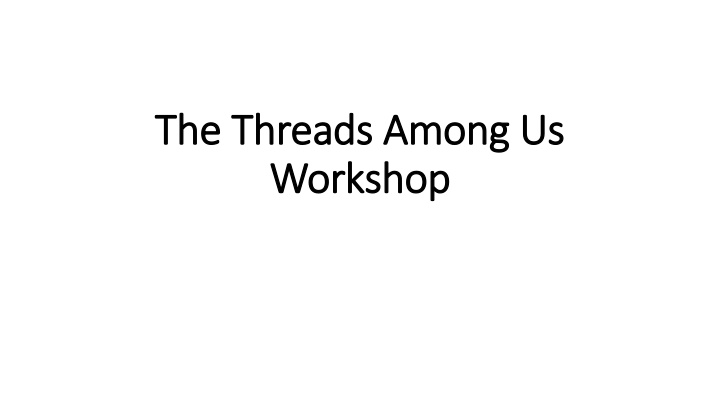



The Threads Among Us Workshop
Activity 1: Social Contagion
Activity 1: Social Contagion • 10 minutes • Divide into groups of 2-3 • Social networks demonstrate spread of emotions and behaviors up to three degrees of influence (e.g. happiness) Dynamic Spread of Happiness in a Large Social Network, BMJ, 2008
Activity 1: Social Contagion • Reflect of the following in your small groups • Have you ever been in a room where an individual has “sucked the energy” out of the room? • Have you ever seen an example of an individual who lifted the spirits of those working around them?
Activity 1: Social Contagion We influence and are influenced up to three Every interaction we have is an opportunity to be the index case in either a positive or negative outbreak of social contagion.
Activity 2: “The Threads Among Us” Video
Activity 2: Video Debrief • Are there any general comments about the content of the video that you would like to share? • What scenarios portrayed in the video struck a chord with you and why?
Activity 2: Video Debrief • Are there any general comments about the content of the video that you would like to share? • What scenarios portrayed in the video struck a chord with you and why?
Activity 3: The Ladder of Inference
Activity 3: The Ladder of Inference • 10 minutes • Divide into groups of 2-3 • One member of each group should record answers to share at the end of the activity • Answer questions as a group
Activity 3: The Ladder of Inference • Example: (Observation) I am cut off in traffic (Assumption) That person is a selfish jerk (Response) I’m going to honk my horn at the person who cut me off • This can become like a “knee jerk” reaction • i.e. rapid and unconscious
LADDER OF NEGATIVE EXAMPLE POSITIVE EXAMPLE INFERENCE RESPOND When surgeons call consults, the We respond in accordance When surgeons call consults, the senior resident is impatient with with our beliefs senior resident appreciates that this them, rolls her eyes and calls the is an opportunity to learn and to consults “ bogus ” . help the surgical team. ASSUMPTION Most surgeons often do care for Most surgeons often do n’ t have all of We make assumptions based medical problems in their patients, the information because the y “ just our personal experiences. but they may have reached the end want to cut. ” of their comfort zone. OBSERVATION Senior resident receives a consult for Senior resident receives a consult We take in surrounding data, anemia from a surgical team, though for anemia from a surgical team, project it in the mind, and our the surgeon cannot supply key though the surgeon cannot supply brains filter it through our own details of the case. key details of the case. unique biopsychosocial filters
Activity 3: The Ladder of Inference • How might the resident’s response influence: • a) her team members? • b) the consulting team’s members? • c) the patient? • Why do you think that the resident was dismissive about this new consult? • It is possible to “Hop off the Ladder?” to pause, reflect, and choose a different path? If so, how?
Activity 4: Gratis Gratitude Card • Take an index card and write a simple “Thank you” or a short note to someone in your workplace who you feel is underappreciated or underrecognized • Give the card to that person, if you are comfortable with this
Activity 4: The “Why?” behind the Gratitude Card • Expressing gratitude: • We overestimate how awkward it will be • We underestimate how surprised the recipient will be • We underestimate how happy the recipient will be • And it’s easy to do! Kumar et al, Psychological Science, 2018
Closing • Thank you for participating in the Threads Among Us workshop • Please fill out the e-mailed surveys to help us: • Improve the course • Collect anonymous data on experiences with incivility in the workplace
Last Slide, Last Moments Together What lessons or reflections from today can you use to make your workplace a better place NOW?
Recommend
More recommend